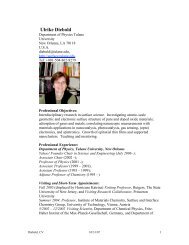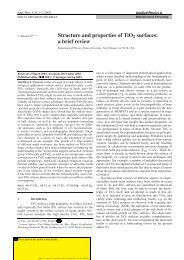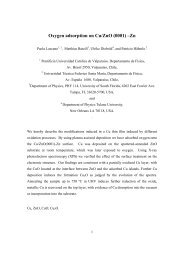The surface science of titanium dioxide - Niser
The surface science of titanium dioxide - Niser
The surface science of titanium dioxide - Niser
You also want an ePaper? Increase the reach of your titles
YUMPU automatically turns print PDFs into web optimized ePapers that Google loves.
94 U. Diebold / Surface Science Reports 48 (2003) 53±229<br />
Fig. 23. (A) Geometry<strong>of</strong> the unreconstructed TiO 2 (1 0 0)-(1 1) <strong>surface</strong>. This <strong>surface</strong> results when the same number <strong>of</strong><br />
Ti ! OasO! Ti bonds are broken in a bulk crystal, see dashed line in (B). <strong>The</strong> formation <strong>of</strong> the …1 3† micr<strong>of</strong>aceted<br />
<strong>surface</strong>, originallyproposed byZschak et al. [186] is displayed in (B). Removal <strong>of</strong> the volume labeled g produces a<br />
stoichiometric <strong>surface</strong> with {1 1 0} facets. In order to reconcile the reduced character <strong>of</strong> the …1 3† <strong>surface</strong> (observed in<br />
photoemission), the outermost bridging oxygen atoms (g 0 ) are thought to be missing as well [187]. <strong>The</strong> transition from the<br />
(1 1) <strong>surface</strong> to the …1 3† micr<strong>of</strong>aceted <strong>surface</strong> was proposed to occur via breaking the bonds a which leads to the<br />
indicated relaxation and creation <strong>of</strong> an intermediate …1 3† phase [176]. (C) A <strong>surface</strong> X-raystructure analysis byZajonz et al.<br />
[192] implied a modi®ed, heavilyrelaxed model. (D) <strong>The</strong> glancing angle X-raydiffraction data that had lead to the original<br />
micr<strong>of</strong>acet model was re-evaluated byLandree et al. [193] and a new structure has been proposed. <strong>The</strong> octahedra model<br />
schematic representations in (D) show the micr<strong>of</strong>acet model (top) and the new model (bottom) (from Landree et al. [193]).<br />
straightforward prediction <strong>of</strong> the stable <strong>surface</strong> termination (Fig. 23A). Again, the same number <strong>of</strong><br />
Ti ! OasO! Ti need to be broken, as indicated bythe line in Fig. 23B. This results in a strongly<br />
corrugated <strong>surface</strong>, with rows <strong>of</strong> bridging oxygen atoms at the outermost, (1 0 0)-oriented ridges<br />
(Fig. 23A). Indeed a (1 1)-terminated LEED pattern is observed on this <strong>surface</strong> after sputtering and<br />
annealing, and STM and non-contact AFM images are consistent with this model [176,177].<br />
Several theoretical calculations have determined likelyrelaxations <strong>of</strong> the (1 1) <strong>surface</strong><br />
[68,101,178,179]. In [178] different theoretical approaches and basis sets were tested. All these<br />
calculations agree in the general motions <strong>of</strong> the atoms, although the amount <strong>of</strong> relaxations differ<br />
somewhat. As expected from symmetry, no relaxations occur along [0 0 1]. In the [1 0 0] direction only<br />
the ®vefold coordinated Ti atoms show appreciable (downwards) relaxations [68]. Substantial<br />
relaxations occur along the [0 1 0] direction with the tw<strong>of</strong>old coordinated and the threefold coordinated<br />
oxygen atoms moving in opposite direction <strong>of</strong> the ®vefold and sixfold coordinated Ti atoms. In<br />
Fig. 23A, O atoms would move to the right and Ti atoms to the left. <strong>The</strong> net effect <strong>of</strong> these<br />
displacements is to increase the effective coordination <strong>of</strong> the ®vefold coordinated Ti atoms [178].







